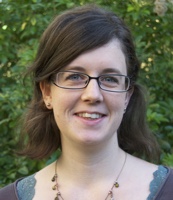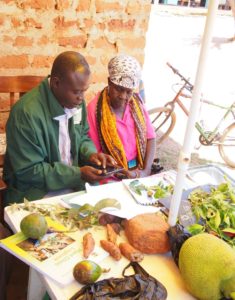Plantwise: Using Wireframes to Test Software for Farmers in Developing Countries
 This is another great story of a Champion who blogged about a project we couldn't have imagined our software being used for. Abigail Rumsey wrote a blog post called "Mocking up the Plantwise Knowledge Bank" that described the process of creating, improving, and testing web and mobile applications for farmers in developing countries. Balsamiq Mockups was used for the wireframes.
This is another great story of a Champion who blogged about a project we couldn't have imagined our software being used for. Abigail Rumsey wrote a blog post called "Mocking up the Plantwise Knowledge Bank" that described the process of creating, improving, and testing web and mobile applications for farmers in developing countries. Balsamiq Mockups was used for the wireframes.
Abbie works at a non-profit called Centre for Agriculture and Biosciences International (CABI) that helps farmers around the world protect and grow their crops by spreading scientific agricultural knowledge.
She is involved in a program called Plantwise, which she describes this way:
Plantwise is a global programme to help farmers lose less of their crops to pests. The programme assists countries in setting up a ‘plant health system’, which mirrors a human national health system, involving ‘plant doctors’ that diagnose farmers’ crop problems at plant clinics, and other stakeholders such as diagnostic services and research organisations.
Personally, I loved learning about this project through my correspondence with Abbie. I also found it interesting how the experience of designing, refining, and testing software felt so familiar, despite the context being so unfamiliar. The lesson being that, regardless of the purpose or personas of your software, there's nothing like putting some concepts in front of users and getting their feedback on something they can actually see. It's always eye-opening and teaches you things you never would have predicted.
Read on for my interview with Abbie...
Q&A with Abigail Rumsey
What is your role with Plantwise and what do you like about it?
My official job title is ‘Content Developer (Technical Solutions), Plantwise Knowledge Bank’ but that’s a bit of a mouthful! The Plantwise Knowledge Bank (PWKB) provides information and tools to people within the plant health system, both online and offline. I work on, among other things, translating the user’s requirements into specifications for IT.
I started off working in the content side of things for the PWKB, managing the quality monitoring of factsheet records and text mined distribution records for our database. I have been fortunate that my team has allowed me to follow my interests in technology and contribute my skills and knowledge in this area to the Plantwise programme. I always considered playing around with new tools on the internet as just being something I did in my spare time and it took me a long time to realise that it could be more than just a hobby.
Tell me a little more about the project you wrote about in your blog post
Currently, plant doctors collect data on the crops that farmers bring to their clinics either on a paper form or, as part of the ‘e-plant clinic’ pilots that we are running, on a digital form on an Android tablet. For the e-plant clinic pilots we have been using an off-the-shelf data collection app but, as we scale up and as we want to do more with tablets, this is becoming an unsustainable option, so we are now designing our own app.
We wanted to know if plant doctors wanted a data collection app that looked like a form or if they wanted an app that was less obviously a data collection form, which still collected all the same data but, for example, instead of checking a box that said ‘leaves affected’, they would touch a picture of leaves on a plant. The wireframes were printed out on coloured paper (different colours for different versions of the app – form or pictorial) and laminated, then the plant doctors were asked what they thought of each wireframe.
We got a lot of feedback from this session. They quite liked the idea of clicking parts of the plant but it didn’t seem viable because they see a lot of different crop plants so the picture wouldn’t like the crop that they were looking at. They liked the wireframes where there were icons and checkboxes that would limit the amount of typing they had to do. They also suggested things we hadn’t thought of like the option to get a summary of their clinic session (time taken, number of farmers seen etc.) and send this to their supervisor.
We have now found a company to work with to develop the app, and plan to release it by the end of the year. Obviously the real test will be when the plant doctors get to try it out and let us know what they think of it! In the future, we hope to add more features to the app so that the plant doctors will have many tools and reference materials on their tablet and won’t need to carry lots of paper around with them. Possible future features include peer-to-peer messaging and assistance with diagnosis.
What did you do before Plantwise?
Before Plantwise I studied for a Masters degree in biodiversity and conservation, and got a fair amount of work experience both in the office and in the field with conservation NGOs. I ended up at CABI because I wanted to follow my interest in scientific writing and editing, so was looking for jobs with scientific publishers.
What kinds of things are you excited about?
I am excited about emerging internet tools and the opportunities that they are opening up for a more connected world. We are seeing so many examples of citizens of less developed countries using and developing tools that are specific to their needs. For example, the mapping of the Kibera slums and monitoring of national elections in Kenya using crowdsourcing techniques.
Anything else you want me to know about you?
I think my colleagues realised I was a nerd when I applied for the job with a QR code on my CV that linked to an interactive website about me.
What's challenging about your job and how do you deal with it?
It’s tricky working out what users want! We have got a lot better at connecting directly with the users of our tools but it is still difficult when they are in remote places with dodgy internet connections and when there are language barriers. We sometimes ask colleagues or partners in-country to help us with user testing.
What other tools do you use for your job?
The Technical Solutions group uses Trello to manage our Agile workflow, which I find to be a really nice tool to visually keep track of my tasks. We have also been experimenting with Slack for team communication. For creating mockups of tools, apart from Balsamiq, I use the free image software package GIMP. When I’m working with data from different parts of the internet I write a Python script or use a tool called Kimono to create a quick API.
How did you discover Balsamiq and why did you start using it?
I discovered Balsamiq when I started making wireframes as part of my job. One of my colleagues recommended it last year and I haven’t considered using anything else since! We recently tried out myBalsamiq when my team quickly wanted to draw up some designs for a mobile app. It was brilliant how quickly we could all put something together (even those people who hadn’t used the software before), and it was so easy to collaborate and comment on mockups.
What trends do you see in your industry right now?
Mobile is really taking off in agriculture in developing countries. We have gone from a small pilot of using Android tablets in plant clinics in Kenya last year to a large number of plant doctors using them this year. We are also running pilots in Rwanda, India and Sri Lanka, which are going well and greatly speeding up the data collection process. The majority of farmers in the areas where we are piloting have access to basic mobile phones, and many of them are using these to handle money transactions and to keep up-to-date with market prices.
Truly fascinating stuff. Thanks for your time, and keep up the good work!
Do you have a story to share about the awesome things you do with Balsamiq? Send an email to champions@balsamiq.com with your stories or blog posts!





